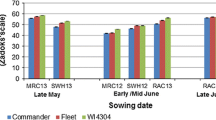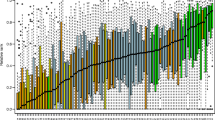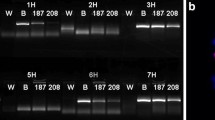Abstract
A bulk-hybrid population of barley (CC-XXI) was investigated for changes over a period of six generations, in (1) generation means and variances for three quantitative characters (2) phenotypic and genotypic frequencies at several marker loci and (3) the components of selection at several life cycle stages (germination and seedling survival, fertility, fecundity) for the dominant-recessive phenotypic classes at three of the above loci. The changes in mean and variance for the quantitative characters appeared to be due to both directional and stabilizing types of selection. The estimates of selective values from frequency data suggested heterozygote advantage along with unequal homozygote fitnesses at locuss and heterozygote disadvantage at locibl, r andv, from computations based on higher outcrossing rates in the presence of male-steriles.
Of the components studied, fertility and fecundity appeared to account for a larger portion of the total selective differential than the pre-adult stages (germination and seedling establishment). Net selective values based on component analysis approximated the selective values obtained from the frequency data for locusr. For locis, andv, however, the two estimates were often quite different, although they generally agreed in direction. The discrepancies between the two sets of estimates were discussed in terms of the complexity of overall measures of fitness.
Similar content being viewed by others
References
Allard, R. W. &S. K. Jain (1962). Population studies in predominantly selfpollinating species. II. Analysis of quantitative genetic changes in a bulkhybrid population of barley.Evolution 16: 90–101.
Allard, R. W., S. K. Jain &P. L. Workman. The genetics of inbreeding populations.Adv. Genet. (in press).
Allard, R. W. &P. L. Workman (1963). Population studies in predominantly self-pollinating species. IV. Seasonal fluctuations in estimated values of genetic parameters in lima bean populations.Evolution 17: 470–480.
Barker, J. S. F. (1963). The estimation of relative fitness ofDrosophila populations. II. Experimental evaluation of factors affecting fitness.Evolution 17: 56–71.
Buzzati-Traverso, A. (1955). Evolutionary changes in components of fitness and other polygenic traits inDrosophila melanogaster populations.Heredity 7: 153–186.
Jain, S. K. &R. W. Allard (1960). Population studies in predominantly self-pollinated species. I. Evidence for heterozygote advantage in a closed population of barley.Proc. Natl. Acad. Sci. U.S. 46: 1371–1377.
Jain, S. K. &C. A. Suneson (1964). Population studies in predominantly self-pollinating species. VII. Survival of a male sterility gene in relation to heterozygosis in barley populations.Genetics 50: 905–913.
Jain, S. K. &C. A. Suneson (1966). Increased recombination and selection in barley populations carrying a male sterility factor. I. Quantitative variability.Genetics 54: 1215–1224.
Knight, G. R. &A. Robertson (1957). Fitness as a measurable character inDrosophila.Genetics 42: 524–530.
Latter, B. D. H. (1962). Changes in reproductive fitness under artificial selection. In “The Evolution of Living Organisms” (Symp. Royal Soc. Victoria): 191–202.
Lerner, I. M. (1958). The genetic basis of selection. John Wiley & Sons, N. Y.
McDonald, D. J. &N. J. Peer (1961). Natural selection in experimental populations ofTribolium. II. Factors affecting the fitness of the mutant “split” ofT. confusum.Heredity 16: 317–330.
Moree, R. &J. R. King (1961). Experimental studies on relative viability inDrosophila melanogaster.Genetics 46: 1735–1752.
Prout, T. (1965). The estimation of fitness from genotypic frequencies.Evolution 19: 546–551.
Reed, S. C. &E. W. Reed (1950). Natural selection in laboratory populations ofDrosophila. II. Competition between a white eye gene and its wild type allele.Evolution 4: 34–42.
Merrell, D. J. &J. C. Underhill (1956). Competition between mutants in experimental populations ofDrosophila melanogaster.Genetics 41: 469–485.
Schlager, G. (1963). The ecological genetics of the mutant sooty in populations ofTribolium castaneum.Evolution 17: 254–273.
Smith L. (1951). Cytology and genetics of barley.Botan. Rev. 17: 1–51, 133–202, 285–355.
Sokal, R. R. &F. J. Sonleitner (1965). Components of selection inTribolium (Coleoptera) and houseflies. Proc. XII Intern. Congr. Entom. (London): 274–275.
Spiess, E. B. (1958). Chromosomal adaptive polymorphims inDrosophila persimilis. II. Effects of population cage conditions on life cycle components.Evolution 12: 234–245.
Spiess, E. B. (1962). Papers on Animal Population Genetics: Introduction (1–71). Little, Brown and Co., Boston.
Strickberger, M. W. (1963). Comparative fitness of experimental populations ofDrosophila pseudoobscura.Heredity 18: 385–395.
Suneson, C. A. &H. Stevens (1953). Studies with bulked hybrid populations of barley. U.S.D.A. Tech. Bull.1067.
Suneson, C. A. &G. A. Wiebe (1962). A “Paul Bunyan” plant breeding enterprise with barley.Crop Sci. 2: 347–348.
Ward, D. J. (1962). Some evolutionary aspects of certain morphological characters in a world collection of barleys. U.S.D.A. Tech. Bull.1276.
Workman, P. L. &S. K. Jain (1966). Zygotic selection under mixed random mating and self-fertilization: Theory and problems of estimation.Genetics 54: 159–171.
Wright, S. (1951). The genetical structure of populations.Ann. Eugenics 15: 323–354.
Author information
Authors and Affiliations
Rights and permissions
About this article
Cite this article
Jain, S.K., Marshall, D.R. Genetic changes in a barley population analyzed in terms of some life cycle components of selection. Genetica 38, 355–374 (1967). https://doi.org/10.1007/BF01507467
Received:
Issue Date:
DOI: https://doi.org/10.1007/BF01507467




